12.8.10: Civil Administration demolishes Bedouin village of al-Farsiya, in the Jordan Valley
In two waves of demolitions, on 19 July and 5 August, the Civil Administration demolished all the structures in al-Farsiya, a Bedouin village in the northern Jordan Valley, east of which the Shadmot Mehula settlement was built. On 19 July, 70 temporary structures were demolished, of which 26 were shacks in which at least 107 persons, among them 52 children, lived. The rest of the structures were used as kitchens, lavatories, and for farming, including a packing house built 30 years ago in partnership with the Israeli agricultural export firm Agrexco.
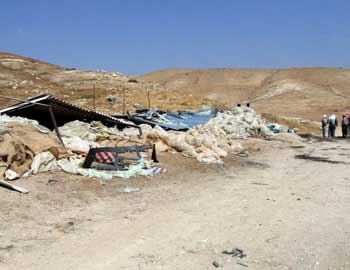
Part of the ruins of the al-Farsiya village, in the Jordan Valley. Photo: ‘Atef Abu a-Rub, B'Tselem, 19 July 2010.
On 5 August, the Civil Administration demolished 10 structures, in addition to 27 tents that the International Red Cross and the Palestinian Authority had provided to residents who had lost their homes in the first wave of demolitions. In the second wave, 22 persons were left homeless, 11 of them children.
During the same period, the Civil Administration also demolished a residential structure in Fasayil, in the central area of the Jordan Valley, leaving nine persons (including six children and one infant) homeless. The Administration also demolished two residential structures and two sheep enclosures in Khirbet ‘Ein al-Hilweh, next to which the Maskiyot settlement was built, leaving 20 persons, including nine children, homeless. The Administration also confiscated water pumps from the village of Khirbet Samra, in the northern Jordan Valley. These pumps supplied water from collection pools to crops in the village.
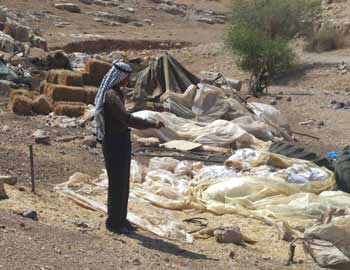
Ahmad Nawaj’a, father of 13, next to the ruins of his family’s shack, in ‘Ein al-Hilwa, which the Civil Administration demolished. Photo: ‘Atef Abu-a-Rub, B'Tselem, 10 August 2010.
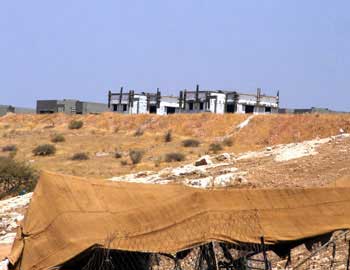
New construction in the Maskiyot settlement, which was built next to ‘Ein al-Hilweh. Residents of the settlement were given a permit to continue the construction during the building freeze in the settlements. Photo: ‘Atef Abu a-Rub, B'Tselem, 10 August 2010.
Also, since June, Civil Administration inspectors have been delivering demolition and eviction orders to dozens of families in the villages of Bardala, al-Hadidiyeh, Frush Beit Dajan, ‘Ein al-Baida, and Khirbet a-Ras al-Ahmar, in the northern Valley. The justification given was that the construction in these communities had been carried out without permits from the Civil Administration. However, Israel does not, as a matter of policy, draft building plans for Palestinian communities in Area C, which is under its sole control. Rather, the Israeli authorities treat all Bedouin structures in the Jordan Valley, whether old or new, as illegal, even though most of the villages existed prior to 1967.
Meanwhile, the Civil Administration allows the settlements established in the Jordan Valley to build extensively, and even retroactively construction carried out without permits. Israel also prevents Palestinians living in the Valley to use the area’s rich water sources, thereby forcing them to buy water that is brought in water tankers, at exorbitant prices.
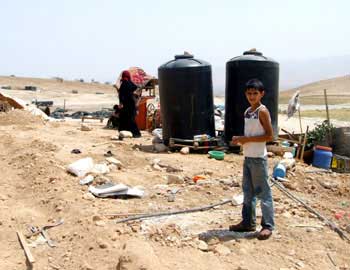
Water tanks of the Dagharmeh family in al-Farsiya. Photo: ‘Atef Abu a-Rub, B'Tselem, 10 August 2010.
The eviction orders required the families to leave within 24 hours. The grounds given were that the structures are situated on land that the army has declared closed. Testimonies that Palestinians gave to B'Tselem indicate that, in fact, the land was used for residential, grazing, and farming purposes even prior to the Israeli occupation, and has never been used for army training, certainly not for firing training. In the past year, the army posted next to these villages dozens of concrete blocks on which it posted signs stating, in Arabic and in English: “Danger. Firing range. Entry forbidden!” The blocks were generally erected next to dirt roads linking the villages with the Allon Road, the main traffic artery connecting between the Jordan Valley settlements.
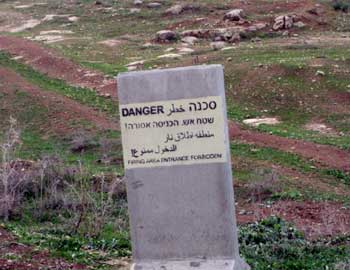
Sign posted by the army at the entrance to a Bedouin community, in the Jordan valley. Photo: Eyal Hareuveni, B’Tselem, 5 January 2010
‘Alan Daraghmeh, 44, who was born in al-Farsiya, related that the army never trained on the village’s land, which is very close to where the Shdemot Mehola and Rotem settlements were built. Taleb ‘Awawdeh, who has lived in al-Hadidiyeh since 1991, said that the army has not trained next to the village. His house is situated less than 100 meters from the houses of the Beqa’ot settlement and several hundred meters form the Ro’i settlement.
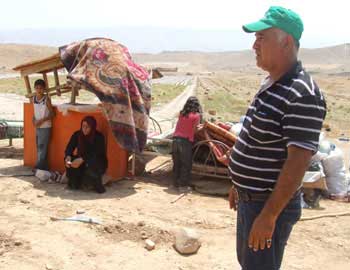
Alan Dagharmeh and members of his family, residents of al-Farsiya, with the remains of their property. Photo: ‘Atef Abu a-Rub, B'Tselem, 10 August 2010.


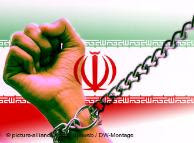




هیچ نظری موجود نیست:
ارسال یک نظر